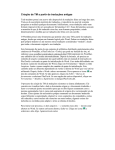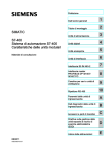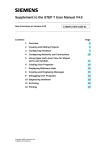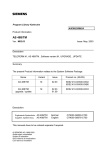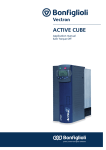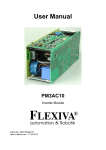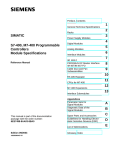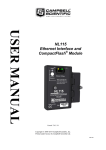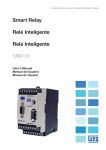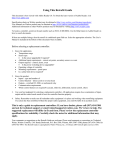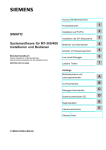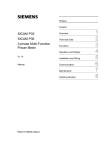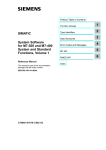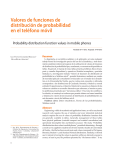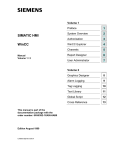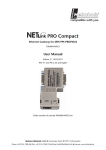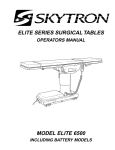Download Sicam SAS System
Transcript
)RUHZRUG&RQWHQWV 7KH6,&$06$66XEVWDWLRQ$XWRPDWLRQ 6\VWHP SICAM SAS 6,&$06$6 +DUGZDUH Substation Automation System 6,&$0SOXV722/6 Overview +XPDQ0DFKLQH,QWHUIDFH 6,&$0:LQ&& 5HIHUHQFHV*ORVVDU\,QGH[ Edition: 19.10.98 E50417-F8976-C016-A1 1 2 3 4 5 Notes on Safety This manual does not constitute a complete catalog of all safety measures required for operating the respective equipment (module, device), since special operating conditions may require additional measures. However, it does contain notes which must be adhered to for your own personal safety and for avoiding property damage. These notes are highlighted with a warning triangle and different keywords indicating different degrees of danger: Warning means that death, severe injury or substantial property damage may occur if the appropriate safety measures are not taken. Caution means that minor injury or property damage may occur if the appropriate safety measures are not taken. Qualified Personnel Commissioning and operation of the equipment (module, device) described in this manual must be performed by qualified personnel only. In the sense of the safety notes contained in this manual, qualified personnel are those persons who are authorized to commission, release, ground and tag devices, systems and electrical circuits in accordance with safety standards. Use as Prescribed The equipment (device, module) must not be used for any other purposes than those described in the Catalog and the technical description. If it is used together with third-party devices and components, these must be recommended or approved by Siemens. Correct and safe operation of the product requires adequate transportation, storage, installation and mounting as well as appropriate use and maintenance. During operation of electrical equipment, it is unavoidable that certain parts of this equipment are carrying dangerous current. Severe injury or property damage may occur if the appropriate measures are omitted: • • • • Before making any connections at all, ground the equipment at the PE terminal. Hazardous voltages may be present on all switching components connected to the power supply. Even after the supply voltage has been disconnected, hazardous voltages may still be present in the equipment (capacitor storage). Equipment with current transformer circuits may not be operated while open. The limit values indicated in the manual or the operating instructions must not be exceeded; this also applies to testing and commissioning. Disclaimer of liability Although we have carefully checked the contents of this publication for conformity with the hardware and software described, we cannot guarantee complete conformity since erorrs cannot be excluded. The information provided in this manual is checked at regular intervals and any corrections which might become necessary are included in the next releases. Any suggestions for improvement are welcome. The contents of this manual is subject to change without prior notice. Siemens Aktiengesellschaft Copyright Copyright Siemens AG 1998 All Rights Reserved This document shall not be transmitted or reproduced, nor shall its contents be exploited or disclosed to third persons without prior written consent from Siemens. Infringements shall entitle to damage claims. All rights reserved, in particular in case of a patent grant or utility model registration. Registered Trademarks SIMATIC®, SIMATIC NET ®, SINAUT® and SICAM® are registered trademarks of SIEMENS AG. All other product and brand names in this manual may be trademarks, the use of which by third persons for their purposes may infringe the rights of their respective owners. Document No. E50417-F8976-C016-A1 Foreword Purpose of this manual This document provides an overview of the functions and components of the SICAM SAS substation automation system. It briefly outlines the procedure for substation parameterization and the functionality of the human machine interface. Target group Substation planners Scope of validity of this manual SICAM SAS V1.0 substation automation system Standards The SICAM SAS substation automation system was developed in compliance with the ISO 9001 standard. Further support If you have any questions about the SICAM SAS system, please contact your Siemens sales representative. Courses For our individual range of courses, please contact our training center: Siemens AG Energieübertragung und -verteilung Sekundärsysteme Humboldtstr. 59 90459 Nürnberg Phone: ++49 9 11/4 33-70 05 Fax: ++49 9 11/4 33-79 29 Recycling and disposal For environmentally-friendly disposal and comprehensive recycling, please contact: Siemens AG Technische Dienstleistungen ANL A 44 Kreislaufwirtschaft Postfach 3240 91052 Erlangen Phone: ++49 91 31/7-3 33 19 Fax: ++49 91 31/7-2 66 43 SICAM SAS Overview E50417-F8976-C016-A1 i Foreword Documentation Overview This overview will give you a rough idea of which information or guideline can be found in which manual. • Which hardware and software components are necessary for covering the requirements of my project? Planning • Can I integrate existing components? • Can I use my PC? • Which system knowledge is necessary for system management? /16/ SICAM SAS Overview /15/ SICAM SAS Planning and Design • Who can provide support on technical and handling questions? Ordering • Is my order complete and correct? /15/ Assembling, mounting hardware components /13/ SICAM SAS Planning and Design • Which safety measures are required? • Which order of things and which rules must be observed during installation? SICAM SAS Mounting Instructions • How do I proceed for installing? Installing the software • Which details have to be observed when authorizing? • Which prerequisites must be given? ii /17/ SICAM, Manual Configuration System SICAM plusTOOLS for SAS /19/ SICAM, Manual Human Machine Interface SICAM WinCC SICAM SAS Overview E50417-F8976-C016-A1 Foreword • Which is the right order for configuring/parameterizing? Configuring / parameterizing • Where do I set which parameters? • How do I download my data to the PLC? • Which tools are available for a data test? • How can I document my data? • How do I archive data? /16/ SICAM SAS Overview /17/ SICAM, Manual Configuration System SICAM plusTOOLS for SAS On-line help system • Where do I configure a control? Configuring the control • Which functions are included as blocks in the scope of delivery? • How do I test and compile the configured control? /18/ SICAM, Manual SICAM plusTOOLS CFC Blocks /17/ SICAM, Manual Configuration System SICAM plusTOOLS for SAS /5/ SIMATIC S7, Manual CFC /1/ SIMATIC S7, STEP 7 Basic Information On-line help system Commissioning • How do I avoid disturbances, accidents when commissioning my system / during operation? • Which persons are able/are authorized to operate my system? /13/ Human Machine Interface SICAM SAS Mounting Instructions • Which solutions are offered by the system? • How do I design my system’s user interface? • How do I configure the interface to the Substation Controller? /16/ SICAM SAS Overview /19/ SICAM, Manual Human Machine Interface SICAM WinCC /20/ SICAM, Manual Measured/Metered Value Processing Utility SICAM Valpro /6/ WinCC Documentation On-line help system SICAM SAS Overview E50417-F8976-C016-A1 iii Foreword Measured value and metered value archives • Which functions are offered by the SICAM SAS system? • Which data volumes can be stored in which format? • Which kinds of evaluation are possible? /16/ SICAM SAS Overview /19/ SICAM, Manual Human Machine Interface SICAM WinCC /20/ SICAM, Manual Measured/Metered Value Processing Utility SICAM Valpro /6/ WinCC Documentation On-line help system Diagnostics/ troubleshooting • Does the system require any maintenance? • What is the reason for a system fault indication, what is the appropriate remedy? • Where can I configure additional error messages? /14/ iv SICAM SAS Maintenance and Diagnostics SICAM SAS Overview E50417-F8976-C016-A1 Contents 1 2 3 The SICAM SAS Substation Automation System . . . . . . . . . . . . . . . . . . . . . . . . 1-1 1.1 Overview . . . . . . . . . . . . . . . . . . . . . . . . . . . . . . . . . . . . . . . . . . . . . . . . . . 1-1 1.1.1 Applications . . . . . . . . . . . . . . . . . . . . . . . . . . . . . . . . . . . . . . . . . . . . . . . . 1-1 1.1.2 Functions . . . . . . . . . . . . . . . . . . . . . . . . . . . . . . . . . . . . . . . . . . . . . . . . . . 1-2 1.1.3 Quantified project scope . . . . . . . . . . . . . . . . . . . . . . . . . . . . . . . . . . . . . . 1-2 1.1.4 System architecture . . . . . . . . . . . . . . . . . . . . . . . . . . . . . . . . . . . . . . . . . . 1-3 1.1.5 Configuration . . . . . . . . . . . . . . . . . . . . . . . . . . . . . . . . . . . . . . . . . . . . . . . 1-4 1.2 Requirements . . . . . . . . . . . . . . . . . . . . . . . . . . . . . . . . . . . . . . . . . . . . . . 1-5 SICAM SAS Hardware . . . . . . . . . . . . . . . . . . . . . . . . . . . . . . . . . . . . . . . . . . . . . . 2-1 2.1 SC Substation Controller . . . . . . . . . . . . . . . . . . . . . . . . . . . . . . . . . . . . . . 2-1 2.2 Bay devices . . . . . . . . . . . . . . . . . . . . . . . . . . . . . . . . . . . . . . . . . . . . . . . . 2-2 2.3 External interfaces . . . . . . . . . . . . . . . . . . . . . . . . . . . . . . . . . . . . . . . . . . 2-3 SICAM plusTOOLS . . . . . . . . . . . . . . . . . . . . . . . . . . . . . . . . . . . . . . . . . . . . . . . . . 3-1 3.1 Project organization . . . . . . . . . . . . . . . . . . . . . . . . . . . . . . . . . . . . . . . . . 3-1 3.2 Substation controller . . . . . . . . . . . . . . . . . . . . . . . . . . . . . . . . . . . . . . . . . 3-2 3.3 Bay device connection . . . . . . . . . . . . . . . . . . . . . . . . . . . . . . . . . . . . . . . 3-5 3.4 Communication with telecontrol centers . . . . . . . . . . . . . . . . . . . . . . . . . . 3-6 3.5 Substation topology . . . . . . . . . . . . . . . . . . . . . . . . . . . . . . . . . . . . . . . . . . 3-8 3.6 CFC functions . . . . . . . . . . . . . . . . . . . . . . . . . . . . . . . . . . . . . . . . . . . . . . 3-9 3.7 Information distribution in the system . . . . . . . . . . . . . . . . . . . . . . . . . . . . 3-11 SICAM SAS Overview E50417-F8976-C016-A1 i Contents 4 5 SICAM WinCC . . . . . . . . . . . . . . . . . . . . . . . . . . . . . . . . . . . . . . . . . . . . . . . . . . . . . 4-1 4.1 Project organization . . . . . . . . . . . . . . . . . . . . . . . . . . . . . . . . . . . . . . . . . . 4-2 4.2 SICAM wizards . . . . . . . . . . . . . . . . . . . . . . . . . . . . . . . . . . . . . . . . . . . . . 4-3 4.2.1 Creating structure types . . . . . . . . . . . . . . . . . . . . . . . . . . . . . . . . . . . . . . 4-3 4.2.2 Transferring tags . . . . . . . . . . . . . . . . . . . . . . . . . . . . . . . . . . . . . . . . . . . . 4-3 4.2.3 Creating a message management system . . . . . . . . . . . . . . . . . . . . . . . . 4-4 4.2.4 Transferring indications . . . . . . . . . . . . . . . . . . . . . . . . . . . . . . . . . . . . . . . 4-6 4.2.5 Creating the archive system . . . . . . . . . . . . . . . . . . . . . . . . . . . . . . . . . . . 4-7 4.2.6 Importing symbol library . . . . . . . . . . . . . . . . . . . . . . . . . . . . . . . . . . . . . . 4-7 4.3 Graphic display . . . . . . . . . . . . . . . . . . . . . . . . . . . . . . . . . . . . . . . . . . . . . 4-8 4.3.1 Designing the static diagram components . . . . . . . . . . . . . . . . . . . . . . . . . 4-10 4.3.2 Designing dynamic image components . . . . . . . . . . . . . . . . . . . . . . . . . . . 4-11 4.4 Message lists . . . . . . . . . . . . . . . . . . . . . . . . . . . . . . . . . . . . . . . . . . . . . . . 4-14 4.5 Archives . . . . . . . . . . . . . . . . . . . . . . . . . . . . . . . . . . . . . . . . . . . . . . . . . . . 4-16 Human Machine Interface . . . . . . . . . . . . . . . . . . . . . . . . . . . . . . . . . . . . . . . . . . . 5-1 5.1 Monitoring . . . . . . . . . . . . . . . . . . . . . . . . . . . . . . . . . . . . . . . . . . . . . . . . . 5-1 5.2 Control . . . . . . . . . . . . . . . . . . . . . . . . . . . . . . . . . . . . . . . . . . . . . . . . . . . . 5-2 References Glossary Contents ii SICAM SAS Overview E50417-F8976-C016-A1 The SICAM SAS Substation Automation System 1.1 1 Overview To ensure the supply security of your substation, your automation system must acquire and evaluate a large volume of single indications during normal operation. In the event of a fault, you require additional information that can support you in fast fault diagnostics. Graphic display functions, reports, and curve displays are suitable tools. The SICAM SAS substation automation system is a system solution enabling effective implementation of these tasks on the substation level. SICAM SAS is designed to be an open system that provides simple interfaces for the integration of additional bay device types or new transmission protocols on the basis of international standards as well as interfaces for implementing project-specific automation functions. 1.1.1 Applications The SICAM SAS substation automation system is used wherever q q q q q q SICAM SAS Overview E50417-F8976-C016-A1 distributed processes are monitored and controlled functions are becoming increasingly decentralized and are processed and visualized in the process environment a real-time capable system is required interference immunity is important great demands are placed on the electrical strength and electro-magnetic compatibility communication with other control systems must be possible. 1-1 The SICAM SAS Substation Automation System 1.1.2 Functions The SICAM SAS substation automation system performs the following tasks: q q q q q q q q q 1.1.3 Telecommunication Monitoring Remote control/control with switchgear interlocking Connection of protection/bay devices Automation Processing of measured and metered values Conditioning and display of information Reporting Archiving Quantified project scope The SICAM Substation Controller of the modular SICAM SAS substation automation system processes up to 3,040 points of information centrally via up to 95 input/output modules. As an alternative, you can connect three control centers and up to 96 bay devices with a total volume of information of 10,000 single information items in a decentralized configuration via the communication modules of the system. Depending on the structure of your substation, you can parameterize these centralized and decentralized points of information as q q q q q q q 1-2 Single, double and/or fleeting indications, Single and/or double commands Measured values Metered values Transformer tap positions Bit patterns Digital scheduled values SICAM SAS Overview E50417-F8976-C016-A1 The SICAM SAS Substation Automation System 1.1.4 System architecture Control center SICAM SC PS 20A DC 48/20 1 2 INTF BATT1F BATT2F BAF DC5V DC24V SICAM plusTOOLS 3 DCF77 IEC 870-5-101 XC2 CR MCP MCP XF6 XF6 CPU 488-3 0XX0000-0XX00 0XX0000-0XX00 0XX0000-0XX00 0XX0000-0XX00 0XX0000-0XX00 ; ; ; ; ; ; X X X X X X X CP xxx CP xxx 0' %$ 0' 3 %$ 0'3 $ $ 3 0 CP'xxx %$ 0' CP3 xxx %$ 0' CP xxx %$ 3 6ES7 CP xxx 41x-1XJ00-0AB0 INTF EXTF SD HD USR1 USR2 INTF EXTF LOAD FAULT1 TXD1 RXD1 FAULT2 TXD2 RXD2 RUN STOP RUN STOP FMR FAULT1 TXD1 RXD1 FAULT2 TXD2 RXD2 INTF EXTF LOAD FAULT1 TXD1 RXD1 FAULT2 TXD2 RXD2 RUN T1 STOP RESET RUN STOP 5 8 1 3 581 T1 R1 RESET R1 T2 T2 R2 R2 T3 T3 R3 R3 T4 T4 R4 R4 T5 T5 R5 R5 T6 T6 R6 R6 67 23 05 (6 BATT 1 BATT 2 6<1 & 6<1 & Configuration ; 2BATT OFF 1BATT / ; ; X1 EXT.-BATT. - / 3( ; ; ; 5...15V DC SIMATIC NET/MPI 1 ... 24 1 ... 31 HMI, archiving SICAM WinCC Protection devices with IEC 870-5-103 (FO interface) Fig. 1-1 MBU with IEC 870-5-103 Example of a configuration with SICAM SAS substation automation system The substation automation system consists of: q q q q q q The SICAM SC Substation Controller Connections with higher-level control centers Connections with the bay level External time signal reception Configuring PG/PC with SICAM plusTOOLS SICAM WinCC human machine interface system The communication concept of your substation automation system is largely determined by the physical location of the equipment. For more information, please consult the SICAM SAS Technical Description /12/. SICAM SAS Overview E50417-F8976-C016-A1 1-3 The SICAM SAS Substation Automation System 1.1.5 Configuration The easy-to-use SICAM plusTOOLS configuration system supports your data acquisition in a technology and operation-oriented way. To configure your human machine interface flexibly, make use of the numerous functions of the SICAM WinCC HMI system. Both systems are based on the now widespread windowing technique and permit fast, low-cost, and easy-to-understand configuration. Copy functions on all levels, selection from predefined hardware catalogs, a set of symbols, operating aids such as the drag and drop function all minimize the effort required to configure and parameterize your substation. For example, if you want to copy individual modules of the substation controller or a complete rack, all the parameters are transferred and adapted automatically. For configuration of HMI functions, it is also very efficient to define and copy sample bays or standard equipment. The samples supplied help you with that. By drag and drop, you can configure the components of your substation very easily simply by selecting an item of information and dragging it to the location where you require it with the mouse. You can use this function for placing modules in the Substation Controller, connecting bay devices or creating your substation topology. The configured data are checked for consistency, errors are displayed as plain text messages in the dialog and also logged. 1-4 SICAM SAS Overview E50417-F8976-C016-A1 The SICAM SAS Substation Automation System 1.2 Requirements Hardware • Standard Pentium PC • 200 MHz • 1GB hard disk • 32 MB RAM • SIMATIC NET communication boards Operating system WINDOWS 95 / WINDOWS NT SICAM plusTOOLS The components of the SICAM plusTOOLS configuration system are supplied on CD. The software package also contains the authorization disks and the SIMATIC STEP 7 automation software with the SIMATIC Manager for hardware configuration of the SICAM Substation Controller, the CFC software for configuration of automation functions, the M7 SYS operating system and the Borland C/C++ Compiler. SICAM WinCC For the SICAM WinCC human machine interface system, you select the volume of variables, which depends on the volume of information of your substation, and obtain the appropriate software package on CD including the WinCC standard software and the necessary authorizations. SICAM SAS Overview E50417-F8976-C016-A1 1-5 The SICAM SAS Substation Automation System Previous knowledge Your personnel must be familiar with the windowing technique now common in many applications for the system management. Internal system knowledge or programming skills are not required. Configuration and parameterization with SICAM plusTOOLS requires knowledge of the technology and telecontrol on the part of your staff. Knowledge of the SIMATIC automation system and the STEP 7 configuration system are also helpful. The user guidance is based on the windowing technique. You design the system’s user interface using SICAM WinCC. Designing network images or curve displays requires experience with using graphic systems. Defining message lists and archives requires technological knowledge and familiarity with the windowing technique. The design of the substation automation system, i.e. implementing the system management requirements in guided operating steps, a clear display concept, a coherent designation system, and an optimum communication structure of the hardware components, requires experience in the configuration of extensive substations and a solid grasp of the following subjects: q q q q q System management Telecontrol Automation Communication Graphic systems. A comprehensive help system supports you with detailed questions on-line. Our development-oriented training center prepares you for efficient use of your SICAM SAS substation automation system. In addition, you can make individual use of the range of courses offered for the components of the SIMATIC S7/M7-400 automation system and the WinCC standard system. 1-6 SICAM SAS Overview E50417-F8976-C016-A1 SICAM SAS Hardware 2.1 2 SC Substation Controller The hardware of the SICAM Substation Controller is based on the standard components of the SIMATIC S7/M7-400 automation system and on modules that were specially developed for the special requirements of power system management. Standard automation functions and power system management specific applications, such as real-time processing, safe command output, or telecontrol functions form a future-oriented and robust hardware system. The Substation Controller is mounted in a standard cabinet with degree of protection IP54 and can be operated without a fan. Depending of the volume of data of your substation and the chosen concept for communication with higher-level control centers and with bay devices, you can configure your Substation Controller to consist of: q q q q q q q q q q UR1 module rack PS power supply CPU MCP, XC2, XF6 communication boards (MCP assembly) DI digital input modules CO command output modules CR command release modules AI analog input modules IM interface modules for expansion racks and SIMATIC standard input/output modules You plug the modules into the central controller and up to 6 expansion units. Each expansion unit requires its own power supply module and an interface module for linking the backplane bus systems of the racks. All the modules that can be used are listed in a hardware catalog and it is quick and easy to combine them to form a SICAM SC using SICAM plusTOOLS. SICAM SAS Overview E50417-F8976-C016-A1 2-1 SICAM SAS Hardware 2.2 Bay devices By connecting bay devices, you can access extensive detailed information about your substation in the substation automation system. The use of protection devices makes a considerable contribution toward preventing expensive damage. New system functions support you in locating and remedying faults locally. The information from these devices is transmitted via standardized protocols such as IEC 60870-5-103 or Profibus. It is possible to integrate customer-specific protocols into the system via existing interfaces. All the bay devices that can be used are listed in a bay device catalog in the SICAM plusTOOLS configuration system. In configuring the bay device connection with the SICAM SC, the full range of information of the selected bay device is offered and you can reduce it as required. The bay devices communicate with the higher-level control centers via the communication boards of the Substation Controllers. 2-2 SICAM SAS Overview E50417-F8976-C016-A1 SICAM SAS Hardware 2.3 External interfaces The variability and expansion capability of a substation automation system largely depends on its interfaces with external equipment. SICAM SAS supports international standards, such as Profibus, the IEC 870-5-101 telecontrol protocol, or the bay device protocol IEC 60870-5-103, and thus guarantees optimum, free substation planning. For the IEC protocols, you can set a transmission rate of up to 19,200 bit/s. The communication boards of the SICAM SC are fitted with serial interfaces (parameterizable as RS232 or RS422/485) and with fiber-optic cable connections. They are combined to form MCP assemblies as appropriate for the application, consisting of the MCP communication processor and XC2 and/or XF6 expansion modules. Control center connection Via the serial interfaces of the MCP communication processor and the XC2 expansion modules, you connect the SICAM SC to up to three higher-level control centers (two-channel if required). Communication is conducted using the telecontrol protocol. Bay device connection For interference-immune connection of your bay devices, you use the XF6 expansion modules with up to six fiber-optic cable connections each. You configure a bay-device protocol as the transmission protocol. You can integrate bay devices with a serial interface into the SICAM SAS substation automation system using the interfaces of the MCP communication processor and/or XC2 expansion module. You can then operate these interfaces with a bay-device protocol. The physical location of your equipment determines the type of connections used. Distances greater than 1,500 m are covered with glass-fiber cables, distances less than 500 m with PCF fiber-optic cables. For distances up to 3 m, you can also use low-cost plastic cables. Time signal reception SICAM SAS Overview E50417-F8976-C016-A1 The MCP communication processor has an interface for receiving an external time signal. Time synchronization is achieved by DCF77, GPS, or IRIG-B. 2-3 SICAM SAS Hardware Note: You can obtain detailed information about the hardware of the Substation Controller, the process interfaces and the communication options of the SICAM SAS substation automation system from the SICAM SAS Technical Description /12/. 2-4 SICAM SAS Overview E50417-F8976-C016-A1 SICAM plusTOOLS 3 You configure and parameterize the SICAM SAS substation automation system with SICAM plusTOOLS, a modern software system that makes use of the advantages of the windowing technique for user guidance. It is based on the software standard of the SIMATIC M7 automation system. The user interfaces are designed specifically for power system management, and familiar data structures can be represented in a flexible way. Easy-to-use applications support you in configuration of the Substation Controller, the bay device connection and connection to the higher-level control centers. In configuration with SICAM plusTOOLS, you are not bound to any particular sequence. Configuration of the Substation Controller or baydevice connection can be performed separately from the description of the telecontrol data of the control center connection. That way, you can have the system configured by your experts in team work. 3.1 Project organization You start your configuration activities with a few organizational steps that define the project structure. Creating a project • First of all, open the SIMATIC Manager, create your project, and give it a name of your choice. Inserting a substation • Now insert your SICAM SAS as a SIMATIC 400 station and give it a name in accordance with your naming conventions. SICAM SAS Overview E50417-F8976-C016-A1 3-1 SICAM plusTOOLS 3.2 Substation controller Your SICAM Substation Controller consists of the components: • UR1 rack Basic modules • PS power supply modules • CPU Interface modules • IM transmit and receive interface modules MCP assembly An MCP assembly consists of the communication boards: • MCP communication processor • XC2 expansion modules • XF6 expansion modules Input/output modules • DI digital input modules • CO command output modules • CR command release modules • AI analog input modules The configuration of your Substation Controller depends on the volume of information of your substation and on your communication concept. You can distribute the input/output modules with the central information points of your substation to up to seven racks. You must observe a few module insertion rules. For example, the IM interface modules are always plugged into the right-hand most slot of the rack, the PS power supply module into slot one. The configuration system checks that these rules are observed and the plausibility of your parameterization. 3-2 SICAM SAS Overview E50417-F8976-C016-A1 SICAM plusTOOLS The hardware configuration application in your SIMATIC Manager provides you with a hardware catalog containing all the available modules for you to select. Each module is provided with a short technical description. • Click on the module with the mouse and drag it to the intended slot in the UR1 rack or mark the slot and insert the selected module by double-clicking the module name. • Then parameterize the specific characteristics of the module. To do that, mark the module and switch to the appropriate tab. Fig. 3-1 Configuring and parameterizing SICAM SC Copy functions on the module and rack levels support you in configuration of the SICAM SC. If you copy a ready parameterized module, the system updates the slot addresses automatically, for example, and checks for consistency. In configuration of the MCP assemblies of the SICAM SC, you define the communication interfaces of the SICAM SAS substation automation system with the higher-level control centers and with the bay devices. You configure the transmission protocol, transmission rate, and interface standard for each interface. You can access these definitions when connecting the bay devices and higher-level control centers. An MCP assembly consists of the MCP communication processor and the XC2 and XF6 expansion modules. The modules form a hardware unit. SICAM SAS Overview E50417-F8976-C016-A1 3-3 SICAM plusTOOLS Project structure Fig. 3-2 After you have stored the information that you have configured with the hardware configuration application, SICAM plusTOOLS creates all the necessary organization structures and containers for further configuration and parameterization. SICAM plusTOOLS project structure • Under Hardware, you find the configuration of the SICAM SC, i.e. the rack(s) with the parameterized modules. • In the SICAM Information Manager SIM, all the information items of your substation control system are managed. In the SIM table, you define the distribution of the information items in the system, for example, communication with the SICAM WinCC HMI system or processing of the information by the CFC automation function. • The connection of the SICAM SC with the higher-level control centers is described in the COM TC. • The COM IED contains all single information items of your bay devices. • Under MCP, you will find configuration of the communication interfaces of the system. SICAM plusTOOLS creates a separate directory for each MCP assembly of the SICAM SC. • Under CPU \ M7 program, you can call up the CFC blocks for graphic configuration of command processing or complex processing functions, such as switching sequences and interlocks. The formation of derived information items, such as group indications or limit value checks is also configured via this interface. 3-4 SICAM SAS Overview E50417-F8976-C016-A1 SICAM plusTOOLS 3.3 Bay device connection You connect the bay devices with the distributed information points of your substation automation system to RS485 serial interfaces or to fiberoptic cable interfaces of the MCP assemblies of the SICAM SC for which the IEC 870-5-103 bay device protocol is configured. For the system dialog, SICAM plusTOOLS provides you with all the available bay devices in a catalog for selection. You connect the bay devices via RS485 serial interfaces or via FO interfaces with the IEC 870-5-103 bay device protocol. You insert the selected devices by drag and drop and parameterize the version number in accordance with your hardware. SICAM plusTOOLS stores the complete information volume of the bay devices in the COM IED. You can adapt the names of the bay devices to your designation system. In the next step, you can define to which interface of the MCP assembly the bay device is connected and therefore via which protocol and at what rate the information of the bay device is transmitted. Fig. 3-3 SICAM SAS Overview E50417-F8976-C016-A1 SICAM plusTOOLS bay device connection 3-5 SICAM plusTOOLS Here is an extract of the information stored for the bay device in a distance protection application. You can delete individual items of information that are not required. Fig. 3-4 3.4 Information of a distance protection device Communication with telecontrol centers In distributed systems, reliable communication between substation automation systems and higher-level control centers are of central importance. In the SICAM SAS substation automation systems, this communication goes through the serial interfaces of the MCP assemblies. They can communicate on two channels with up to three control centers. You define the interfaces themselves during configuration and parameterization of the MCP assemblies. SICAM plusTOOLS creates the COM TC application via which you configure individual telegrams that you want to exchange. Communication from Substation Controllers and higher-level control centers uses telecontrol protocols such as IEC-870-5-101 with the baud rate set in the MCP assembly. 3-6 SICAM SAS Overview E50417-F8976-C016-A1 SICAM plusTOOLS Control center connection • Select COM TC and insert your control centers. • Configure the connection of the control centers to the MCP assemblies. We recommend describing the individual telecontrol telegrams in the control and monitoring directions as the last step in your configuration with SICAM plusTOOLS, because this sequence ensures optimum user guidance. • Select the information items that you require for communication with the control center. In the control direction, all command contacts of the Substation Controller and the bay devices are offered, and in the monitoring direction, all signals and measured and metered values that have so far been acquired for the station, including internally derived information. In the monitoring direction, processing of information items is grouped together in telecontrol lists. Fig. 3-5 SICAM SAS Overview E50417-F8976-C016-A1 SICAM SAS control center connection 3-7 SICAM plusTOOLS 3.5 Substation topology Structure the information items acquired in accordance with the topology of your substation. For example, you can structure them hierarchically creating a tree structure with voltage levels and bays. You can put your data in any structure and use switchgear and bay device types as the sorting criterium, for example. With the SIM Browser of SICAM plusTOOLS, you can adapt the internal data structure individually to your operational requirements. In the SIM Browser, you can see the information items of your substation configured so far. The information items are stored in alphabetical order. You will find the system and status indications of the modules and bay devices in a separate block. • First define the substation topology, create the required groups on the different levels of the hierarchy and enter a unique name. • Now move the individual items of information into the areas by drag and drop. For example, you can place higher-level indications directly below the voltage level, and bay information items below the bay group, changing the names of the information items if necessary. Fig. 3-6 SIM Browser data structure This easy-to-use method allows you to configure the Substation Controller and the bay device connection largely independently of the topology of your substation information system. If you want to move single information items from one area to another, you can do it easily at any time by this method. 3-8 SICAM SAS Overview E50417-F8976-C016-A1 SICAM plusTOOLS 3.6 CFC functions The CFC automation function is used in SICAM SAS for command processing, configuring operating sequences and interlocks and to generate derived items of information. SICAM plusTOOLS is supplied with a pool of predefined CFC blocks with which you can implement the most common automation functions in power system management. For example, if you require group indications for communication with higher-level control centers, configure a CFC block which combines the associated single indications. • To do that, first insert a new information item into the SIM Browser for the result variable of the CFC combination and identify it with CFC in the source column of the SIM table. • Now create the CFC variable names in the CFC column for the input and output variables of the CFC block. You require these names for graphic configuration of the module. Fig. 3-7 SIM table with CFC references and CFC variables SICAM SAS Overview E50417-F8976-C016-A1 3-9 SICAM plusTOOLS After these preparatory steps, start actual CFC configuration. • Insert a plan container in the SIMATIC Manager, create a new CFC block or select an existing block from the pool of CFC blocks supplied. • Define the priority class of the block. • Enter the CFC variable names from the SIM table for the inputs and outputs of the selected block. Fig. 3-8 3-10 Graphic configuration with CFC SICAM SAS Overview E50417-F8976-C016-A1 SICAM plusTOOLS 3.7 Information distribution in the system During operation, your indications are logged, switching states displayed in detailed diagrams, measured values displayed as curves and archived if required. So that individual system components such as the SICAM WinCC HMI system or the CFC automation function can access the configured information, mark the relevant columns in the SICAM Information Manager SIM. Monitoring direction Fig. 3-9 Information distribution in the monitoring direction Source The source identifies the origin of the information item. This entry tells you whether it is an information item formed internally by CFC or an external item of process information. CFC CFC variable names that are required for graphic configuration of the CFC automation functions. HMI The current value of the single information item is displayed in the graphic displays. The current measured and metered values are archived. to HMI1 -HMI2 A single item of information is displayed and/or archived in the SICAM WinCC message management system. Is process feedback of Name of the command for which the information item is the feedback. SICAM SAS Overview E50417-F8976-C016-A1 3-11 SICAM plusTOOLS Control direction Fig. 3-10 Information distribution control direction Destination The destination column identifies the destination of the information. This entry tells you whether the command is output via a module of the Substation Controller (MIM) or via a bay device (COM IED). With CMD release Command output with command release via the CR module CFC IN CFC OUT CFC variable names for command processing by CFC. From HMI1 -HMI2 Command output is triggered by the HMI system. Feedback Name of the information item which is the feedback for the command. Note: The information items that you have identified in columns HMI1 and HMI2 can be accepted and further processed by the SICAM WinCC HMI system. To complete configuration with SICAM plusTOOLS, compile the generated data and load them into the Substation Controller. For more detailed information, please consult the manuals SICAM, Manual Configuration System SICAM plusTOOLS for SAS /17/ , SICAM, Manual SICAM plusTOOLS CFC Blocks /18/ and SICAM SAS Technical Description /12/. 3-12 SICAM SAS Overview E50417-F8976-C016-A1 SICAM WinCC 4 In the SICAM SAS substation automation system, SICAM WinCC is the human machine interface HMI between the user and the computerassisted monitoring and control system. For efficient system management, numerous single information items must be displayed quickly and clearly. The state of the substation must be displayed and logged correctly at all times. Important indications, measured and metered values of past time periods must be archived in such a way that they are available for specific evaluation in the form of curves or tables at any time. The SICAM WinCC Human Machine Interface meets these requirements for efficient system management and also provides you with numerous options for individual design of the system user interface and numerous open interfaces for implementing operation-specific functions. The windowing technique of SICAM WinCC makes it easier to work with. In designing the graphic displays, you have every degree of freedom and also have the support of a pool of predefined substation automation symbols such as switchgear, transformers, or bay devices. SICAM SAS Overview E50417-F8976-C016-A1 4-1 SICAM WinCC 4.1 Project organization You start designing your system’s user interface with a few organizational steps that are required to create the project management structure, to load preparameterized data and to access the information items parameterized with the SICAM plusTOOLS configuration system. Creating a project After SICAM WinCC has been started, first create your project with File →New. Fig. 4-1 4-2 SICAM WinCC project structure SICAM SAS Overview E50417-F8976-C016-A1 SICAM WinCC 4.2 SICAM wizards After that, call up the die SICAM WinCC Dynamic Wizards in the graphics designer and prepare configuration of your system user interface. You can use the wizards to perform the following tasks: q q q q q q 4.2.1 Creating SICAM structure types Transferring tags from SICAM plusTOOLS Creating the SICAM message system Transferring messages from SICAM plusTOOLS Creating the SICAM archive system and Linking the SICAM symbol library. Creating structure types The SICAM wizard Create tag structure types creates the data types for SICAM WinCC’s internal further processing of information items that you want to transfer from SICAM plusTOOLS. 4.2.2 Transferring tags The information items that your require for tag description of your graphic displays you can take over using the wizard Import SICAM tags in your SICAM WinCC project. This gives you access to all information items that you have marked “yes” in the SIM table of SICAM plus TOOLS as part of information distribution in the system in columns HMI, HMI1, and HMI2. The information items are stored by their hierarchical names in the tag logging. SICAM SAS Overview E50417-F8976-C016-A1 4-3 SICAM WinCC 4.2.3 Creating a message management system In addition to the extensive standard functions of WinCC, expansions are available in SICAM WinCC for alarm logging that was specially designed for implementation of substation-automation-specific requirements and are created by the wizard Create SICAM message management. It generates the message window, message classes, message lines and message blocks for: Message window Event classes Message lines q Event list q Alarm list q Protection message list q q q q q q q q q q q 4-4 SICAM event list, all event classes SICAM alarm list, all SICAM messages SICAM protection message list, all SICAM protection messages SICAM message SICAM message with acknowledgement on rising edge SICAM message with acknowledgement SICAM event SICAM protection message SICAM event list format: Date / time / message text / place / cause / status / value / additional cause / code number / additional information / number SICAM alarm list format: Date / time / message text / value / cause SICAM protection message list format: Date / time / message text / value / unit / code number SICAM SAS Overview E50417-F8976-C016-A1 SICAM WinCC Message blocks Text library q q q q q q q q Value Status Cause Place Additional cause ID number Additional information Unit From the information items of the process value blocks, such as status, cause or additional cause, the Create SICAM message management wizard derives a language-specific standardization DLL from the associated message text and assigns it. The texts can be customized. The text library contains the following texts: Command acknowledgement positive General interrogation Transmission blocked Metered value scan Local Automatic Double indication on defined position Persistent command stop Transformer tap position Organizational indication SICAM SAS Overview E50417-F8976-C016-A1 4-5 SICAM WinCC Raw data variable The runtime system of the SICAM Substation Controller passes the indications with their current process value to SICAM WinCC via a raw data variable. The Create SICAM message management wizard creates this raw data variable. This raw data variable ensures chronologically correct signaling and archiving of process information. Message sequence report 4.2.4 The message sequence report contains the definitions of the format for output of the indications on printer. As the default, the assistant defines a report format for all event classes. By selecting individual alarm blocks, you can set the relevant report scope and layout of the alarm blocks for your project. Transferring indications You can transfer the information items that you want to log in your alarm lists into your SICAM WinCC project using the Import SICAM messages wizard. This gives you access to all data that you have marked “yes” in the column for HMI1 and HMI2 in the SIM table of SICAM plusTOOLS as part of the information distribution in the system. The information items are stored in the pool of indications under their hierarchical name. The wizard assigns the raw data variables as event and acknowledgement variables, enters the reference to the SICAM standardization DLL and an indication number. 4-6 SICAM SAS Overview E50417-F8976-C016-A1 SICAM WinCC 4.2.5 Creating the archive system The archive system (tag logging) manages the measured value and metered value archives of the SICAM WinCC HMI system. The Create SICAM archive wizard creates the archives and assigns all measured and metered values that you have marked with “yes” in the HMI column in SICAM plusTOOLS to the associated archive. The size of the archive is determined by the capacity of your hard disk. You can adapt the archiving cycles to your operating conditions. . 4.2.6 Importing symbol library To facilitate the design of your graphic displays in the Graphics Designer, a symbol library is supplied with SICAM WinCC which contains typical substation automation symbols such as switchgear, bay devices, transformers and patterns for bay displays. The elements of the symbol library are dynamized. You can transfer them into your SICAM WinCC project using the Importing library into project wizard. SICAM SAS Overview E50417-F8976-C016-A1 4-7 SICAM WinCC 4.3 Graphic display Clear display of the current state of the substation is very important for efficient system management. SICAM WinCC is a powerful graphic system for individual design • of your overview diagram and • your detail diagrams. These diagrams have static components (background image) and variables that visualize the switching state of switchgear, selections or measured and metered values. Fig. 4-2 4-8 Example of an overview diagram SICAM SAS Overview E50417-F8976-C016-A1 SICAM WinCC Fig. 4-3 SICAM SAS Overview E50417-F8976-C016-A1 Example of a detail diagram 4-9 SICAM WinCC 4.3.1 Designing the static diagram components You design the static diagram components (background image) using the Graphic Designer. You can use the following tools to draw the objects: • Object palette with all common objects such as line, circle, rectangle, arc, elipse, polygon etc. • Color palette and • Editing functions such as duplication, rotation, enlargement, mirroring, alignment, etc. Fig. 4-4 4-10 Background image design SICAM WinCC SICAM SAS Overview E50417-F8976-C016-A1 SICAM WinCC 4.3.2 Designing dynamic image components After you have placed all the items of equipment, selection fields, measured and metered value display fields and static diagram components, you can make your image dynamic by defining the object properties of the individual symbols. If you use objects from the symbol library supplied to display your equipment, they are already partially dynamic to meet the requirements of substation automation. You only have to assign to these variables the information from the tag logging that you transferred from SICAM plusTOOLS . Object properties The object properties depend on the type of object. The main object properties are q q Attributes such as blinking, color change and/or Actions such as press mouse button. The object properties are defined in: q q SICAM SAS Overview E50417-F8976-C016-A1 Monitoring direction by a dynamic dialog and/or C actions Control direction by assignment of C actions. 4-11 SICAM WinCC If you want to dynamize a circuit breaker in the monitoring direction, you assign properties to its various display modes (closed, open, undefined) in the dynamic dialog. You can select color display, filling pattern and/or blinking modes. You can also assign the attributes to the associated item of information. Fig. 4-5 Dynamizing attributes in the monitoring direction You can define C actions for input/output fields. An input/output field is capable of actions such as: q q q q 4-12 Sum calculation, Minimum / maximum / mean calculation or Percentage calculation. Counting switching cycles SICAM SAS Overview E50417-F8976-C016-A1 SICAM WinCC In the control direction, you define the behaviour of the circuit-breaker on switching operations by assigning C actions to its various display modes. Fig. 4-6 Dynamizing attributes in the control direction You define C actions for buttons. A button can be assigned actions such as: q q q q SICAM SAS Overview E50417-F8976-C016-A1 Image and list selection Switching command Tap changing command Scheduled value output 4-13 SICAM WinCC With this flexible assignment of dynamic attributes and actions, you can already implement numerous functions by configuring the variables. You will find further information in the descriptions: SICAM, Manual Human Machine Interface SICAM WinCC /19/ WinCC Documentation /6/ and WinCC Configuration Manuals /7/. 4.4 Message lists In the SICAM SAS substation automation system, you log information in the control and monitoring directions in the indication lists: q q q Event list Alarm list and Protection message list The Create message management wizard of SICAM WinCC creates preparameterized lists and defines the permissible event classes. You assign one event class to each information item to be logged and in this way distribute them to the indication lists. One indication can be logged in more than one list. The layout of the indication lists is freely selectable. You can change predefined formats to meet your requirements using the alarm logging. 4-14 SICAM SAS Overview E50417-F8976-C016-A1 SICAM WinCC Event list Fig. 4-7 Example of a SICAM WinCC event list Alarm list Fig. 4-8 Example of a SICAM WinCC alarm list Protection message list Fig. 4-9 Example of a SICAM WinCC protection message list SICAM SAS Overview E50417-F8976-C016-A1 4-15 SICAM WinCC 4.5 Archives SICAM WinCC manages the measured and metered value archives in the SICAM SAS substation automation system with the tag logging standard function. With the Create SICAM archive wizard, you have already created • the measured value archive and • the metered value archive and transferred information of type measured value and type metered value from SICAM plusTOOLS. You select the values to be archived in the SIM table of SICAM plusTOOLS by marking the measured and metered values in the HMI column. The archiving cycles of these process value archives are selectable. The instantaneous value or processed values, e.g. sums, maximum / minimum or mean values are stored. The archives are evaluated in the form of: • curves and/or • tables. 4-16 SICAM SAS Overview E50417-F8976-C016-A1 SICAM WinCC SICAM Valpro Instantaneous values are displayed as curves and tables using the SICAM Valpro application. With SICAM Valpro, it is also possible to use archive values for various evaluations without changing them in the archive. You decide at the time of evaluation in a guided dialog which values you want displayed in what time base. You define not only the variables to be displayed, but also q q q the time range, the color and if necessary the calculation function to be executed. You can calculate sums, mean values, maxima, minima, or power factors and have them displayed. You can define the calculation interval individually. You can change stored defaults at any time. Fig. 4-10 Example of curve evaluation using Valpro For more detailed information, please consult SICAM, Manual Measured/Metered Value Processing Utility SICAM Valpro /20/. SICAM SAS Overview E50417-F8976-C016-A1 4-17 SICAM SAS Overview E50417-F8976-C016-A1 Human Machine Interface 5.1 5 Monitoring The information of the substation automation system in the monitoring direction is displayed in the overview diagram and in detail diagrams and logged in message lists. Spontaneous state changes of information items usually have to be acknowledged. For example, you might have configured an Acknowledge button for that purpose, for which you have defined how an acknowledged state change is displayed and/or what actions result from the acknowledgement. • Click on the Acknowledge button with the mouse and trigger the acknowledgement in the display. Fig. 5-1 Acknowledging a state change SICAM SAS Overview E50417-F8976-C016-A1 5-1 Human Machine Interface 5.2 Control You can trigger output in the control direction from a detail diagram, if you have assigned an action to the symbol for the switching device when you dynamize the variable and have defined a dialog for that purpose. • Click on the switching device with the mouse. A dialog box with the switching states CLOSED and OPEN and a cancellation option is output. Fig. 5-2 5-2 Positioning switchgear SICAM SAS Overview E50417-F8976-C016-A1 Human Machine Interface • Click on the target switching state, CLOSED in the example. Fig. 5-3 Selecting the switching direction • Click on Execute. Fig. 5-4 Executing the switching command SICAM SAS Overview E50417-F8976-C016-A1 5-3 Human Machine Interface After the command has been successfully output, the new switching state of the switching device is displayed. Fig. 5-5 5-4 Target position of the switching operation reached SICAM SAS Overview E50417-F8976-C016-A1 References SICAM SAS Overview E50417-F8976-C016-A1 /1/ SIMATIC S7, STEP 7 Basic Information Consisting of: Setting Up and Programming the S7-300 Easily, STEP 7 User Manual, Programming Manual for the S7-300/400, and Converter Manual 6ES7810-4CA03-8BA0 /2/ SIMATIC S7/M7, S7-400, M7-400 Programmable Controller Manual including instruction list 6ES7498-8AA00-8BA0 /3/ SIMATIC M7, Technical Overview: The S7-400 Programmable Controller - Configuration and Application 6ES7498-8AA00-8BB0 /4/ Manual M7-SYS Draft versions of user programs for the SIMATIC M7-300/-400 for use under RMOS32, consisting of programmer, user and reference manual 6ES7 802-0FA01-8BA0 /5/ SIMATIC S7, Manual CFC 6ES7813-0CA02-8BA0 /6/ WinCC Documentation 6AV6392-1XA04-1AB0 /7/ WinCC Configuration Manuals 6AV6393-1CA04-0AB0 /8/ SICAM, Manual Analog Input Function Module AI32/16 E50417-G8976-C004-A1 /9/ SICAM, Manual Digital Input Function Module DI32 E50417-G8976-C005-A1 /10/ SICAM, Manual Command Output Function Module CO32 E50417-G8976-C006-A1 /11/ SICAM, Manual Command Release Function Module CR E50417-G8976-C007-A1 /12/ SICAM SAS Technical Description E50417-T8976-C010-A1 /13/ SICAM SAS Mounting Instructions E50417-B8976-C011-A1 /14/ SICAM SAS Maintenance and Diagnostics E50417-W8976-C012-A1 /15/ SICAM SAS Planning and Design References-1 References E50417-P8976-C015-A1 References-2 /16/ SICAM SAS Overview E50417-F8976-C016-A1 /17/ SICAM, Manual Configuration System SICAM plusTOOLS for SAS E50417-H8976-C017-A1 /18/ SICAM, Manual SICAM plusTOOLS CFC Blocks E50417-H8976-C018-A1 /19/ SICAM, Manual Human Machine Interface SICAM WinCC E50417-H8976-C019-A1 /20/ SICAM, Manual Measured/Metered Value Processing Utility SICAM Valpro E50417-H8900-C020-A1 SICAM SAS Overview E50417-F8976-C016-A1 Glossary Address We distinguish between two different types of addresses: q q For identifying a certain module (slot, rack) For identifying a certain operand or operand area (e.g. input I12.1). AI The Analog Input module is available with 16 relay inputs or with 32 solidstate inputs. APA → Job buffer Application The SICAM plusTOOLS configuration system is divided into the following function-specific applications: SIM, COM IED, COM TC and Hardware Configuration. Automatic reclosing Automatic reclosing is a function which is frequently used in power distribution for extinguishing electric arcs on overhead lines. Automatic reclosing means that a closed circuit-breaker is opened and reclosed after a short delay. Automation computer The control functions are performed by a computer program and are not permanently stored in a retentive memory (→ programmable logic controller). Automation system An automation system is a → programmable logic controller or an → automation computer from the SIMATIC S7/M7 family. Back-up battery The back-up battery ensures that pre-defined data areas, flags, timers and counters are held as retentive. SICAM RTU and SICAM SC work without a back-up battery. Bay device Bay devices include: q q q q Bay controllers Mini bay units Protection devices Measuring instruments → IED SICAM SAS Overview E50417-F8976-C016-A1 Glossary-1 Glossary Bay device protocol IEC 60870-5-103 (VDEW Protocol) Bit pattern indication A bit pattern indication is a processing function on the digital input module which makes it possible to jointly acquire and process digital processrelated information which is present at several inputs in parallel. As bit pattern size, you can choose between 1, 2, 3 and 4 bytes. BO_x → Bit pattern indication (bitstring of x bits); x designates the size in bits (8, 16, 24 or 32 bits). Bus A bus is a transmission medium which interconnects several stations. Data transmission can be serial or parallel, via electric cables or via fiber optic cables. Central controller The central controller is the equipped rack which contains the SIMATIC M7 CPU of the SICAM SC. Central rack → Rack CFC Continuous Function Chart. CFC is a graphic editor which allows you to configure a program using prefabricated blocks. CFC blocks Blocks are parts of the application program which are defined by their function, their structure or their purpose. With SICAM plusTOOLS, you will receive a library of blocks which have been especially designed for substation control and protection systems. Chatter blocking A fast intermittent input (e.g. as a result of a relay contact fault) is disconnected after a parameterizable monitoring time and cannot produce any further signal changes. This function prevents the system from being overloaded in case of a fault. CI → Restore command (counter interrogation command) CO Command output module Code block In a SIMATIC S7/M7, a code block is a block which contains part of the application program (as opposed to a → data block, which contains only data.) COM IED Communication to Intelligent Electronic Devices. This application is used for configuring the communication to bay devices. Glossary-2 SICAM SAS Overview E50417-F8976-C016-A1 Glossary COM TC Communication to Telecontrol Centers. This application servesis used for configuring the communication to higher-level control centers. Command ending With the command ending function, a running command output is terminated upon expiration of the parameterized output time or upon arrival of the process feedback assigned to it. Commands Commands are safe process outputs with a defined output time. Before the output voltage is switched through, a number of checks is performed (e.g. one-out-of-n monitoring, readback of the relay drivers, impedance and electrical isolation of the load, etc.). Communications processor The MCP communications processor manages the communication of a SICAM SC (Substation Controller) with higher-level telecontrol centers and/or bay devices. The number of interfaces which are available can be increased by using the XC2 and XF6 expansion modules. The TP1 communications processor enables the SICAM RTU to exchange data with one or several control centers. Configuration Configuration means arranging, addressing and parameterizing the modules of the SICAM Substation Controller and the SICAM RTU in a → rack with the help of the Hardware Configuration application. Container The SICAM plusTOOLS data are stored in function-specific containers. Some examples are the SIM Table, the MIM Table, COM IED and COM TC. CPU Central processing unit of the SICAM SC and the SICAM RTU with control and arithmetic unit, memory, operating system and interface for programming devices. CR Command release module Cycle time The cycle time is the time needed by the CPU to execute the application program once. Cyclic interrupt Cyclic interrupts are tasks which are started at regular intervals, i.e. cyclically. Data block Data blocks are data areas within the application program which contain user data. There are global data blocks which can be accessed by all code blocks. DB → Data block SICAM SAS Overview E50417-F8976-C016-A1 Glossary-3 Glossary DCF77 In the Federal Republic of Germany, the high-precision official time is managed by the Physikalisch-Technische-Bundesanstalt PTB (German Federal Testing Laboratories) in Brunswick. The atomic clock station of the PTB broadcasts this time via the long-wave time signal transmitter at Mainflingen near Frankfurt on the Main. The transmitted time signal can be received within a radius of approx. 1500 km around Frankfurt on the Main. DC_PER → Double command, persistent command DC_PUL → Double command, pulse command DI Digital input module Diagnosis alarm Modules with diagnostic capability report system faults which they have recognized by means of diagnosis alarms to the → CPU. Diagnostic buffer The diagnostic buffer is a buffered memory area in the CPU into which the diagnosis events are written in chronological order. Double command Double commands are process outputs which represent 4 process states at 2 outputs: 2 determined states (e.g. ON/OFF) and 2 undetermined states (e.g. fault positions) Double-point indication Double-point indications are items of process information which represent 4 process states at 2 inputs: 2 defined states (e.g. ON/OFF) and 2 undefined states (e.g. fault positions). DP → Double-point indication Drag & drop Copy, move and shortcut function which is commonly used in graphical user interfaces. Objects are selected with the mouse, seized and moved from one data area to another. Electrical fast transient (burst) Procedure for testing the interference immunity (e.g. of the process inputs/outputs). The type of coupling and the physical magnitudes are defined in the IEC 801–4 standard. Electromagnetic compatibility Electromagnetic compatibility (EMC) designates the ability of electrical equipment to function properly in a defined environment without affecting this environment in an unacceptable way. EMC → Electromagnetic compatibility Glossary-4 SICAM SAS Overview E50417-F8976-C016-A1 Glossary Environmental conditions Environmental conditions comprise all external disturbing influences to which electrical equipment may be exposed: Temperature, humidity, electrostatic and electromagnetic fields, mechanical impacts, etc. EPE → Event buffer EPROM An EPROM (Erasable Programmable Read Only Memory) is a voltageindependent, permanently-programmed memory for programs and data. Equipotential bonding Electrical connection (equipotential bonding conductor) which brings the housings of electrical equipment and other conductive station components to equal or nearly equal potential in order to prevent interference or hazardous voltages between those components. Error response Response to a → runtime error. Possible responses of the operating system are: q q q Transition of the automation system to the STOP status Invocation of an organization block / an error task which contains a programmed reaction Error message. Error task Error tasks make it possible to react to certain errors which are recognized by the runtime system during runtime. There are three error classes: I/O access errors, processor errors and time-out errors. ESD protection ESD protection encompasses all means and measures used for protecting electrostatically sensitive devices. Event buffer The event buffer of the inputs (German abbreviation: EPE) is used to buffer preprocessed process events. Each event is made available in a data block. The event buffer is organized according to the “first-in-firstout” principle. If there is at least one data block in the EPE, a → hardware interrupt is issued to indicate that it is ready for collection. Expansion module The XC2 and XF6 modules are designed as expansion modules of the → MCP communications processor. They can only be used in combination with the MCP module (→ MCP assembly) in order to increase the total number of → process-end interfaces. XC2 offers two serial interfaces RS232 or RS485. XF6 provides six interfaces for connecting fiber optic cables. Expansion rack → Rack SICAM SAS Overview E50417-F8976-C016-A1 Glossary-5 Glossary Expansion unit An expansion unit is an → expansion rack connected to the central controller and equipped with a power supply module, an interface module and further modules. FLASH-EPROM (FLASH-EPROM = Flash Erasable Programmable Read Only Memory). FLASH-EPROMs are like the electrically erasable EEPROMs in that they are able to retaindata in case of a power failure, but can be erased far more quickly. They are used on → memory cards. Fleeting indication Fleeting indications are → single-point indications which are present only for a very short time, where only the rising edge of the process signal is acquired and processed in real time. Floating → Isolated FM → Function module Frame Frame designates all interconnected inactive parts of electrical equipment which must not carry any hazardous touch voltage, not even in case of a fault. Front connector Process-end 48-pin module connector. Available with screw-type contacts, crimp contacts and spring-loaded terminals, with conductor crosssections of up to 1.5 mm2. The available cable space has to be observed. Function According to IEC 1131-3, a function (FC) is a → code block without any static data. A function offers the possibility of handing over parameters in the application program. Therefore functions are suitable for programming frequently recurring complex functions (e.g. calculations). Function module Function modules are intelligent signal converters which preprocess process information, thus relieving the → CPU. → Configuration of FMs is done using → parameters. Functional grounding Grounding whose sole purpose is to guarantee that the electrical equipment functions as intended. Functional grounding short-circuits interference voltages which would otherwise lead to inadmissible interferences in the electrical equipment. General interrogation (GI) For the system startup, the state of all process inputs, of the status and the fault image is checked. This information is used for updating the system-end process image. It is equally possible to check the current process state after a data loss with the help of a GI. Glossary-6 SICAM SAS Overview E50417-F8976-C016-A1 Glossary Global data Global data are data which can be addressed from each → code block. This includes e.g. inputs I, outputs O and data blocks DB. Global data can be accessed either absolutely or symbolically. GPS Satellites with atomic clocks on board revolve around the earth on different orbits at an altitude of approx. 20,000 km twice a day. They broadcast signals which include the GPS universal time. The GPS receiver determines its own position on the basis of the signals received. From the position, it can derive the delay time of the satellite signal and thus correct the GPS universal time broadcast. Ground The conductive soil whose electric potential can be equated with zero at any point. Near ground electrodes, the soil can have a potential not equal to zero. This phenomenon is often referred to as “ground reference plane”. Grounding Grounding means connecting an electroconductive component to → ground using a grounding system. Grounding system A grounding system encompasses all means and measures used for grounding. Ground reference plane → Ground Group command With a group command, it is possible to output several successive → commands. This function is used e.g. to implement the busbar change of a feeder in switchgear. Hardware configuration → Configuration Hardware filter The hardware filter eliminates the transient conditions of a digital process signal: The value 1 is only transmitted if the signal level reaches at least 80% of the “1” level for the duration of the parameterized filter time. Hardware interrupt Hardware interrupts are triggered by hardware interrupt signals. These interrupt signals can be assigned to a → task/an → organization block in order to react to external process events. Hierarchical level In a structure with higher-level and subordinate objects, a hierarchical level consists of objects of the same level. HMI Human Machine Interface → SICAM WinCC SICAM SAS Overview E50417-F8976-C016-A1 Glossary-7 Glossary IEC International Electrotechnical Commission, international standardization body → Telecontrol protocol → Bay device protocol IED Intelligent Electronic Device → bay device IM Interface Module for connecting expansion units. Interface → MPI (multipoint interface) → Process-end interfaces Interrupt For the operating system, an interrupt is an event which controls the execution of the application program. There are different interrupt classes. When an interrupt occurs, the operating system automatically invokes an assigned organization block, in which the user can program the desired reaction (e.g. in an FB). → Hardware interrupt → Cyclic interrupt IRIG-B Time signal code of the Inter-Range Instrumentation Group ISO 9001 The ISO 9000 ff. standards define measures for assuring the quality of a product from development to manufacturing. Isolated On isolated input/output modules, the reference potentials of the control and the load circuit are isolated (e.g. by optocouplers, relay contacts or transformers). Several load circuits can be connected to a common potential. IT → Metered value (integrated totals) IWV Indication with value, e.g. a protection device indication with interrupted current or fault location Job buffer The job buffer of the outputs (German abbreviation: APA) is used to buffer → commands on the CO (command output) and CR (command release) function modules. Only one command at a time can be written into the APA. After the command execution, the APA is cleared once again. K bus The K bus (communications bus) is a serial backplane bus which is optimized for the exchange of large data volumes. Glossary-8 SICAM SAS Overview E50417-F8976-C016-A1 Glossary Load memory The load memory is part of the CPU. It contains the objects generated by the programming device (PG) and is either implemented on a plug-in Memory Card or as built-in memory. Load power supply Power supply for powering the input/output circuits, the sensors and the actuators. Main memory The main memory is a RAM on the → CPU which the processor accesses during program execution. MCP assembly An MCP assembly consists of the MCP communications module and the XC2 and/or XF6 expansion modules. These modules are linked by means of lateral connectors and are plugged into the rack as one unit. MCP module → Communications processor Memory Card Memory Cards are storage media in credit card format for the CPU. They are implemented as → RAM or → FLASH-EPROM. ME_NA → Measured value, normalized value ME_NC → Measured value, short floating point Metered value A metered value is a processing function used for determinating the total number of discrete homogeneous events (meter pulses), in most cases as an integral over a time interval. In the power supply industry, it is usual to record electrical energy as a metered value (energy import/energy export, power transmission). MIM → Module Information Manager Module Information Manager The MIM Table shows all connections of the input/output modules which have been chosen in the Hardware Configuration as well as the SAS information currently assigned to it. Module parameters Module parameters are variables which serve for determining the behavior of the module. Moving contact An auxiliary contact on the transformer which indicates whether the tap changing function of the transformer is activated. MPI The multipoint interface (MPI) is the programming device interface of the CPU. It serves as interface for downloading the system configuration which has been parameterized before with SICAM plusTOOLS, and for SICAM SAS Overview E50417-F8976-C016-A1 Glossary-9 Glossary connecting the SICAM WinCC Human Machine Interface. With the help of an MPI, it is possible to realize simple networks. Each station is identified by a unique address (MPI address). MPI address → MPI Multiple command With a multiple command, it is possible to output several → commands simultaneously. Non-isolated On non-isolated input/output modules, the reference potentials of the control and the load circuit are electrically connected. OB → Priority class (M7), → Organization block (S7). Operating system of the CPU The operating system of the CPU organizes all functions and operations of the → CPU which are independent of the control tasks of the application program. Operational status The automation systems of the SIMATIC S7/M7 family know the following operational statuses: STOP, → STARTUP, RUN. Organization block Organization blocks (OBs) constitute the interface between the operating system of the S7-CPU and the application program. In the organization blocks, the order of execution of the application programs is defined. Parameter − Variable of a code block − Variable for determining the behavior of a module (one or several ones per module). Each module has appropriate factory settings, which can be modified with the help of the Hardware Configuration application of STEP 7. P bus The P bus (I/O bus) is a parallel backplane bus optimized for the rapid exchange of I/O data. PG → Programming device PII The process input image reflects the current status of the process inputs. The input modules keep a PII for their inputs. These PIIs are read by the CPU before each user program cycle and are combined to a system-end process input image. Glossary-10 SICAM SAS Overview E50417-F8976-C016-A1 Glossary PIO The process output image reflects the current status of the process outputs. After each user program cycle, the CPU copies the system-end process output image kept in its main memory into the PIO of the output modules. These output the content of their PIO at the outputs. PLC → Programmable logic controller Priority class In the M7 family, priority classes constitute the interface between the operating system of the CPU and the application program. The order of execution of the application program is defined in the → tasks. The priority classes are mapped to RMOS tasks. A priority class corresponds to a → task. Process-end interfaces Interfaces of the → communications processors of the → SICAM SC or the SICAM RTU to higher-level control centers and/or bay devices. Process image Reserved RAM areas of a CPU where the signal states of the input and output modules are stored. Programmable logic controller Programmable logic controllers (PLCs) are electronic controllers whose functions are stored as a program in the control unit. Thus the design and the wiring of the device do not depend upon the function of the controller. Programmable logic controllers have the same components as computers: they consist of a CPU with memory, input/output modules (e.g. DI, AI, CO, CR), power supply module (PS) and rack (with bus system). The I/Os and the programming language are especially designed to meet the requirements of control engineering. Programming device Programming devices (PGs) are compact, portable, industry-standard personal computers. They distinguish themselves by having special hardware and software features suitable for programmable logic controllers. PS Power supply module Rack A rack consists of a flat aluminum extruded section and the backplane PCB. Racks are used for plugging in the modules. RAM RAM (Random Access Memory) is a semiconductor memory for read/ write access. This memory incorporates the main memory of the CPU. RC → Regulation step command SICAM SAS Overview E50417-F8976-C016-A1 Glossary-11 Glossary Regulation step command A regulation step command is a function where the output time of the → command depends upon the command duration in the control center which manages the system. They are suitable for manual setpoint value input in slow closed-loop control circuits. Release The release is part of the command execution. The release switches the command output voltage through to the checked command output circuit for a defined time. RESET The RESET command serves for resetting a device/system and forcing a restart. Restore command Restore command for metered values (counter interrogation command). The restore command is automatically generated as soon as metered value capturing has been parameterized for a DI module or a bay device. The restore command refers to the entire module or bay device. RSxxx interface Serial interfaces of the → MCP assembly (RS232, RS422/485) Runtime error Errors which occur during execution of the application program in the automation system (i.e., not in the process). SA Switch authority command SAS information Items of SAS information are objects in the PG/PC which serve for organizing the distribution of individual items of information in the SICAM runtime system. Each SAS information represents a certain indication or a certain command which is to be distributed within the system. This distribution takes place both between the individual modules and between the connected devices and stations. S bus Via the S bus, the external interfaces of the MCP communications module and its expansion modules XC2 and XF6 are assigned to the interfaces of the MCP controller. SC_PER → Single command, persistent command SC_PUL → Single command, pulse command SC CPU CPU of the SICAM SC from the SIMATIC M7-400 family. SE_Dx Digital setpoint value (setpoint command, digital x bits); x designates the size in bits (8 or 16 bits). Glossary-12 SICAM SAS Overview E50417-F8976-C016-A1 Glossary SE_NA Analog setpoint value (setpoint command, normalized value) SE_NC Analog setpoint value (setpoint command, short floating point) Shielding Grounding whose sole purpose is to guarantee that the electrical equipment functions as intended. Shielding short-circuits interference voltages which would otherwise lead to inadmissible interferences inthe electrical equipment. Short-time indication Single-point indications are parameterized as short-time indications if they are available in the system only for a short time and therefore must be retained for some time in order to guarantee that they are recognized reliably. SICAM RTU Modularly designed terminal unit on the basis of the SIMATIC S7 automation system. SICAM SAS Modularly designed substation automation system on the basis of the → SICAM SC Substation Controller and the SICAM WinCC Human Machine Interface. SICAM SC Modularly designed substation controller on the basis of the SIMATIC M7 automation system. SICAM WinCC The SICAM WinCC Human Machine Interface depicts the state of your power system graphically, visualizes interrupts and indications, archives the power system data, enables you to intervene manually in the process and manages the system access rights of the individual staff members. Signal module Signal modules (SM) are signal converters without any intelligence of their own which carry out a signal level adaptation between the process and the automation system. Signaling circuit A signaling circuit is a circuit used to generate an indication. It includes the signaling-circuit voltage, the signalling contact and the wiring leading to the input of the DI module. Signal status indications Signal status indications are the display elements (light-emitting diodes) at the front panel of the modules. They indicate the status of the process inputs and outputs. Thus, e.g., the signal status indicator of a digital input module lights up if the input voltage is applied to the corresponding input. SIM The SICAM Information Manager application serves for managing the SAS information of the system. SICAM SAS Overview E50417-F8976-C016-A1 Glossary-13 Glossary SIM Browser SICAM Information Browser SIMATIC Manager The SIMATIC Manager is a tool used for configuring the hardware of the → Substation Controller. The SIMATIC Manager constitutes the platform for SICAM plusTOOLS. Single command Single commands are process outputs which represent 2 process states at 1 output (e.g. ON/OFF). Single-point indication Single-point indications are items of process information which represent 2 process states at 1 input (e.g. ON/OFF). Slot A slot is the position in a → rack where the individual modules of an automation system are mounted. For some modules (e.g. PS power supply module, IM interface module), there are fixed slot positions. SMC → Marker command for setting a marker (flag) by the Human Machine Interface. SP → Single-point indication SP_F → Fleeting indication (single point, fleeting) SP_S → Short-time indication (single point, short-time) ST → Transformer tap indication (step position information) STARTUP A device passes the STARTUP operational status during the transition from the STOP operational status to the RUN operational status. The change of the operational status can be triggered by the mode selector switch, after Power-ON or by operator input at the programming device. Station topology Distribution of the system data to different → hierarchical levels and assignment of devices to these hierarchical levels. Status/fault indications Status and fault indications are LEDs which are arranged at the front panel of S7-400 or M7-400 modules. They provide information on the module state. STEP 7 STEP 7 serves as basic software for SICAM plusTOOLS and for CFC. STEP 7 incorporates the programming languages LAD and STL. Substation automation system → SICAM SAS Glossary-14 SICAM SAS Overview E50417-F8976-C016-A1 Glossary Substation controller → SICAM SC Surge immunity → Surge voltage Surge voltage Procedure for testing the interference immunity (e.g. of the process inputs/outputs) according to IEC 60255–5. The type of coupling and the physical magnitudes (peak voltage, rate of rise, etc.) are defined in the IEC standard. System data blocks System data blocks (SDBs) are data areas in the program which contain the system data and which determine operational sequences. System function blocks A system function block (SFB) is a function block which is integrated in the operating system of the CPU. It can be invoked, if necessary, from the STEP 7 application program. System function call A system function call (SFC) is the invocation routine of a system function which is integrated in the operating system of the CPU. With function modules, SFCs are used for reading out the → event buffer of the inputs (EPE), writing into the → job buffer of the outputs (APA) and handing over control commands. System memory The system memory is integrated on the CPU and implemented as RAM. The system memory contains the operand areas (e.g. timers, counters, flags) as well as the data areas internally used by the operating system (e.g. stack memory area). Task Tasks constitute the interface between the operating system of the M7 CPU and the application program. In the tasks, the order of execution of the application programs is defined. A task corresponds to an OB (S7) or a → priority class (M7). Telecontrol protocol IEC 60870-5-101 Thresholds Thresholds are a processing function on analog input modules which are used to reduce the input data volume, where minor signal changes are also processed, provided that they persist for some time. Time stamping Time stamping means assigning real time to a process event. The time stamping on the FMs consists of milliseconds, seconds and minutes. The hour and the date are added on the CPU. TP1 → Communications processor in the SICAM RTU SICAM SAS Overview E50417-F8976-C016-A1 Glossary-15 Glossary Transducer A transducer is an electrical device for the potential isolation and the conversion of a wide variety of measured variables to standardized measuring signals (e.g. load-independent direct current). Transformer tap indication A transformer tap indication is a processing function on DI modules which makes it possible to acquire and process the different transformer tap positions. Transmission protocols → Telecontrol protocol → Bay device protocol Ungrounded Without any electrical connection to the → ground. Valpro Value Processing. SICAM application for creating and editing measured value and metered value graphs. VDEW Vereinigung Deutscher Elektrizitätswerke (Association of German Power Plants), standardization body. Version identifier The version identifier allows the user to identify a module. It includes type, hardware/software release and date of creation. Watchdog A watchdog is a hardware circuit for monitoring a microprocessor. If, due to a hardware or software fault, the periodic restart of an interval fails to take place, an → interrupt (NMI) is triggered on the microprocessor. WinCC → SICAM WinCC X bus The X bus handles the control of the serial multiplexer of the MCP communications module and its XC2 and XF6 expansion modules. XC2 Expansion module within the → MCP assembly for connecting the SICAM SC to higher-level control centers and for connecting → bay devices with serial interfaces. XF6 Expansion module within the → MCP assembly for connecting → bay devices with fiber optic interfaces. Glossary-16 SICAM SAS Overview E50417-F8976-C016-A1 Index A D Alarm list 4-4, 4-14, 4-15 Alarm logging 4-4 Archives 4-16 DCF77 2-3 Detail diagram 4-9 Drag and drop 1-4, 3-5, 3-8 Dynamic dialog 4-11 Dynamizing 4-12 B Bay devices 1-2, 2-2, 3-3 catalog 2-2, 3-5 connection 2-3, 3-5 Button 4-13 E Event list 4-4, 4-14, 4-15 External interfaces 2-3 C F C actions 4-11 Cable glass fiber 2-3 PCF fiber-optic cable 2-3 plastic 2-3 CFC 3-11, 3-12 blocks 3-4, 3-9 functions 3-9 graphic configuration 3-10 Color palette 4-10 COM IED 3-5 COM TC 3-4, 3-6, 3-7 Command release 2-1, 3-12 Communication processor 2-3, 3-3 Configuration 1-6 Consistency check 1-4, 3-3 Construction color palette 4-10 dynamic image components 4-11 editing functions 4-10 object palette 4-10 static diagram components 4-10 variables 4-11 Control center connection 2-3, 3-6 higher-level 3-3 Control direction 3-12, 4-11, 4-13, 5-2 Copy functions 1-4, 3-3 Creating a project 3-1, 4-2 Creating the archive system 4-7 Fiber-optic cable 2-3 SICAM SAS Overview E50417-F8976-C016-A1 G GPS 2-3 Graphic Designer 4-10 Graphic display 4-8 Group indications 3-9 H Hardware 1-5 Hardware catalog 2-1, 3-3 Help system 1-6 HMI 3-11, 3-12, 4-1 Human machine interface system 3-11 I Information distribution 3-11 Interfaces fiber-optic cable 2-3, 3-5 serial 2-3, 3-5, 3-6 IRIG-B 2-3 M MCP assembly 2-3, 3-2, 3-3, 3-4, 3-5, 3-6 Measured value archive 4-16 Message lists 4-14 Message system indication lists 4-14 transferring indications 4-6 Messaging system creating 4-4 event classes 4-4 message blocks 4-5 Index-1 Index message lines 4-4 message sequence report 4-6 message window 4-4 raw data variable 4-6 text library 4-5 Metered value archive 4-16 Monitoring direction 3-11, 4-11, 4-12, 5-1 O Object palette 4-10 Operating system 1-5 Overview diagram 4-8 P Previous knowledge 1-6 Project organization 3-1, 4-2 Protection message list 4-4, 4-14, 4-15 Q importing 4-7 System management 1-6 System user interface 1-6 T Tag logging 4-7, 4-16 Tags transferring 4-3 Time-signal reception 2-3 Training 1-6 Transmission protocols bay-device protocol 3-5 rate 2-3 telecontrol protocol 2-3, 3-6 V Valpro 4-17 Volume of information 1-2 Quantified project scope 1-2 R Range of courses 1-6 Requirements 1-5 S SICAM information manager 3-4 SICAM plusTOOLS 1-4, 1-5, 3-1 COM IED 3-4 COM TC 3-4 SICAM information manager 3-4 SIM 3-4 SIM browser 3-8 SICAM WinCC 1-4, 1-5, 3-11, 4-1 button 4-13 C actions 4-11, 4-13 dynamic dialog 4-11, 4-12 input/output fields 4-12 object properties 4-11 wizards 4-3 SICAM wizard create SICAM archive 4-7 create SICAM message management 4-4 create tag structure types 4-3 import SICAM messages 4-6 import SICAM tags 4-3 importing library into project 4-7 SIM 3-4, 3-11 SIM browser 3-8, 3-9 Substation Controller 1-2, 2-1 Substation controller 3-2 Substation topology 3-8 Symbol library 4-11 Index-2 SICAM SAS Overview E50417-F8976-C016-A1 TO: Siemens AG EV S SUP2 Postfach 4806 D-90026 Nürnberg Germany FROM: Your name : .......................................................................................................... Your title : .......................................................................................................... Your company : .......................................................................................................... Department : .......................................................................................................... Street : .......................................................................................................... City, State : .......................................................................................................... Phone : .......................................................................................................... Fax : .......................................................................................................... Please tick your area of work: q q q q q Automation Mining (incl. strip mining) Chemical industry Power generation Power distribution, power system management q Building services, air conditioning q Heavy machine construction, handling systems q q q q Pipelines Shipbuilding, navigation Environmental technology q Gas/water/sanitary utilities Traffic and transportation q Other........................................................................................... Remarks / Suggestions Your remarks and suggestions will help us to enhance the usability of our documentation. Please fill in this questionnaire and mail or fax it back to Siemens (fax number ++49 - 911 - 7509917). Title of the Manual: SICAM SAS Order no. of the Manual: E50417-F8976-C016-A1 Please answer the following questions by giving a rating between 1 = good and 5 = poor. 1. Does the contents cover your requirements? ................ 2. Could you spot the information you need without any problems? ................ 3. Did you find the texts easy to understand? ................ 4. Does the information depth meet your requirements? ................ 5. How do you judge the quality of the illustrations? ................ If you have encountered any concrete problems, please give us a concise description below: .......................................................................................................................................... .......................................................................................................................................... .......................................................................................................................................... .......................................................................................................................................... .......................................................................................................................................... .......................................................................................................................................... .......................................................................................................................................... .......................................................................................................................................... .......................................................................................................................................... ..........................................................................................................................................










































































